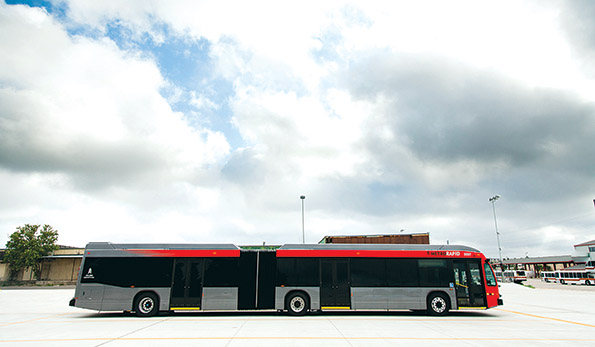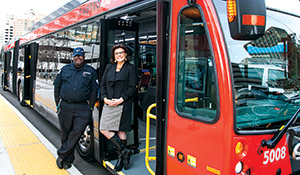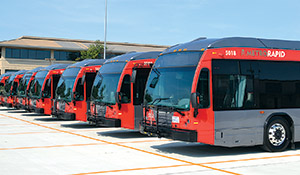
By Francine Pares
Capital Metro, Austin, TX
Communications Manager
Capital Metro recently launched MetroRapid, its Bus Rapid Transit (BRT) line that has been 10 years in the making. The new high-tech, high-capacity, limited-stop bus service began rolling on the streets of Austin in January. This is a very important step forward for the City of Austin, which is growing by 100 people and 70 cars per day and is now ranked the 11th largest in the U.S.
Although BRT and articulated buses have been around for a while, the “bendy” bus, as it’s known in Austin, is an all new sight around town. The MetroRapid vehicles are the Nova LFS 60-foot articulated model. Given the daunting nature of launching a new service in an area accustomed to the status quo, Capital Metro set out a strategic campaign several months ahead of the launch to get the word out. The key was educating the public about BRT and what it could do for them; how it differs from the bus service they are used to.
To prepare for this challenge, the agency assembled its communications, marketing, community involvement and planning teams in a joint session to come up with a wide-ranging list of tactics to help riders navigate the nuances of this entirely new service. MetroRapid would have new routes, stations, vehicles, technology, transit priority lanes and ways to pay — so there was clearly a lot of work to do.
Here are some of the steps the agency took to make sure the launch of MetroRapid would be a success:
Community outreach

The Community Involvement team first identified major areas of possible engagement along the 801, the first of two MetroRapid routes that traverses 21-miles north and south through downtown along one of the densest and highest ridership corridors in the system.
• Outreach at over 50 public and community meetings, including early morning “coffee socials” set up near high-traffic areas like the University of Texas, Chinatown and the downtown Capitol complex.
• Outreach to over 30 civic organizations.
• Participation in well-attended and popular events such as holiday parades, farmers markets, the annual food drive at Whole Foods’ flagship store, and other events celebrating Austin’s unique character.
• Briefings and one-on-one meetings with elected and city officials to keep them in the loop.
• Targeted presentations to large and small businesses in the downtown district where transit priority lanes were being constructed.
• Targeted outreach to key neighborhood groups and associations located near the new stations.
• Outreach by street teams at major stops along nearby routes to answer questions and hand out information.
Long-range communications
The Communications team put together a long-range communications plan that would take them past the launch date to maximize PR and other promotional opportunities.
• Several “sneak peek” events and tours aboard MetroRapid with reporters, elected officials and business and community leaders to acquaint them with the vehicles, stations and benefits.
• Extensive media pitching to TV and radio stations, newspapers, magazines and online publications using a variety of different news angles to obtain consistent coverage.
• One-on-one briefings with influential reporters and senior management to encourage fair and accurate coverage.
• Implementation of a comprehensive and interactive social media campaign using informative and fun posts, videos and photos on Facebook, Twitter, Pinterest and the agency’s blog.
• Regular communications to stakeholders and employees from the president/CEO regarding important project milestones.
• A grand opening celebration with over 250 dignitaries, partner agencies, contractors, employees and media in attendance.
Unique marketing
A large array of unique marketing pieces have informed, educated and delighted the public. This advertising campaign included whimsical and edgy ads for TV, radio, print, digital and social media; as well as novel outlets such as pedicabs.
• Creation of an upbeat teaser video several months prior to launch to build excitement.
• Creation of several fun and lively “How to Ride” videos and a “hero” video, promoted extensively using the agency’s social media sites and partner websites.
• Creation of branded brochures, station signage, maps, passes, passenger notes, interior placards, exterior vehicle ads, presentation boards, displays and event programs.
• A 3-D billboard strategically placed near a major freeway showing a MetroRapid vehicle bursting through the canvas.
• Creation of a project-specific micro-site within the agency’s website, available in both English and Spanish.
• Creation of branded giveaways, including red and silver coffee mugs and pens, a specially designed poster, flash drives, branded t-shirts, and water bottles with an “articulated” bendy middle.
• A mural by a well-known local artist on the exterior of a prominent and highly visible downtown building near the capitol.
• Creation of a mobile app campaign, including a “buy one get one free” pass promotion.

To maximize the rider experience after launch, Capital Metro had more than 200 staff and volunteer “ambassadors” at stations and onboard vehicles to answer questions and assist with some of the new amenities, including three-door boarding and a new “tap” farebox system. Ambassadors put in more than 1,000 total hours during this effort, which proved to be a key element of the rollout’s success.
Initial reports show that people are enjoying the faster and more frequent service, the cool new vehicles, free Wi-Fi, high-tech stations with real-time information, and the new mobile app that lets riders buy and use tickets on their smart devices. The agency is pleased with the multi-disciplinary approach it took to keep the public in-the-know, concluding that it was well worth the effort.
Ultimately, it is the riders who matter most, and Capital Metro will continue to look for innovative ways to engage its growing base of customers while delivering the very best service possible.
